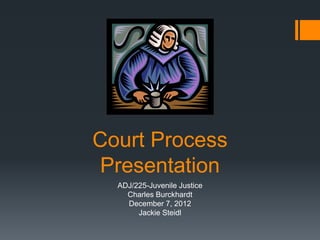
Court process presentation
- 1. Court Process Presentation ADJ/225-Juvenile Justice Charles Burckhardt December 7, 2012 Jackie Steidl
- 2. The Juvenile Court Team Judges Hearing Officers Prosecutors Defense Attorneys Probation Officers
- 3. Rights of the Juvenile Miranda Warning Right to Attorney Confront and Cross-Examine Witnesses Right Against Self-Incrimination Right to Appeal Your Case
- 4. Phases of Filing a Petition Intake Process Refer to Juvenile Court Petition Filed
- 5. Types of Juvenile Sentencing Probation Foster home Community Service Institutions Ward of the Court
- 6. Confidentiality Issues Juvenile Issues Victim and Society Issues
- 7. Restitution Holding Juvenile Accountable
- 8. References: Hess, K. M. (2010). Juvenile justice (5th ed.). Belmont, CA: Wadsworth
Notas do Editor
- The judges are the authority figure of the court, they make the final decision on the juveniles case. The hearing offices assists the judge and enters recommendations and findings. The prosecutor is also a dominant figure, they negotiate the disposition. The defense attorney is there for the best interest of the juvenile, they help defend the juvenile. The probation officer plays the biggest role during the juvenile process, they are usually the first one to talk to the juvenile and they make recommendations to the judge, generally the judge rules on those recommendations.
- Each juvenile when taken into custody has a right to hear their rights which is the Miranda warning, they also have a right to an attorney during their court process to defend them, once in court the juvenile has a right to confront witness and cross-examine witnesses to try and prove their innocence, they also have a right to not take the stand and incriminate themselves or answer questions that may be incriminating to their case. Once through court, if they don’t like the outcome, they have a right to appeal their case. They do not have a right to a jury trial or a right to post bail.
- Before filing a petition, a juvenile has to go through the intake process. Once there at the intake process, the case can be dismissed, referred to another agency, waived to adult court or referred to juvenile court. If they are referred to juvenile court then a petition is filed. The petition includes the name, age, address of the minor, what code sections the minor broke, if charges are misdemeanors or felonies, the name and address of the parents or guardians and a short statement that says what happened and if minor is in custody or has been released to parents (Hess, 2010).
- Since the juvenile is under age their records are kept confidential from the public and in most cases are expunged off their record when they turn 18, this helps the juvenile because the system was put into place to protect and rehabilitate juveniles. If the record is kept private and then expunged when they become of age, this will help them in their future as productive adults, the problem is society and victims want more of the information to be shared such as wanting to know if they have a juvenile delinquent in their neighborhood, almost the same as seeing if they have a child molester or an ex-con in their neighborhood. People want to know if there are dangerous or delinquent people living near them.
- Restitution means holding the juvenile accountable for their actions, this could mean them doing community service to pay for their crime, if fined or if they caused damages to a persons assets the judge can order them to pay for damages. If this happens the juvenile is put in a special center where they work and the pay they make goes to the people who is owed restitution. This helps the juvenile understand the consequences of their actions.